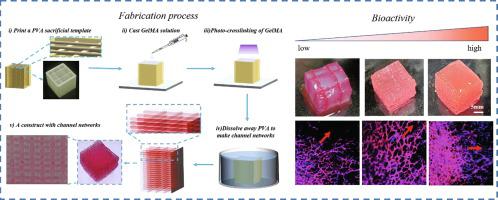Materials & Design ( IF 7.6 ) Pub Date : 2022-08-22 , DOI: 10.1016/j.matdes.2022.111012 Bingchu Pan , Lei Shao , Jinhong Jiang , Sijia Zou , Haoyu Kong , Ruixia Hou , Yudong Yao , Jianke Du , Yuan Jin

|
In hydrogel-based tissue engineering, channel network is an efficient structure for transporting nutrients/oxygen to support cell survival and construct living tissues in vitro. 3D printing can create complex hydrogel-based tissue constructs, however, due to the weak mechanical properties of hydrogel bioinks, cell-laden hydrogel constructs with effective channel networks are difficult to be directly printed. Here, an easy sacrificial 3D printing method based on commercial desktop 3D printer and water-soluble polyvinyl alcohol (PVA) to construct effective hydrogel channel networks is introduced. Specifically, i) commercial PVA consumables are printed to be sacrificial templates; ii) gelatin methacryloyl (GelMA) solution is cast to encapsulate the sacrificial template; iii) the sacrificial template is dissolved to form channel networks. PVA is a water-soluble sacrificial material with sufficient dissolution time and high mechanical strength, which can avoid the disadvantages of classic sacrificial materials (sugar and Pluronic F127). High roundness of printed PVA filaments results in high roundness of the channel networks. The interconnected channel networks accelerate the supply of oxygen/nutrients and promote cell growth. And with a period of culture, the higher the channel networks density, the better the cell growth. Additionally, PVA sacrificial templates have high stability and long-term preservation, facilitating transportation, circulation and use, which is conducive to the manufacturing and promotion of hydrogel-based constructs with channel networks. Taken together, our easy strategy of manufacturing hydrogel constructs with channel networks has broad application prospects, such as 3D cell culture, construction of functional tissue in vitro or tissue repair in vivo etc.
中文翻译:

用于制造具有通道网络的水凝胶结构的 3D 打印牺牲模板
在基于水凝胶的组织工程中,通道网络是一种运输营养/氧气以支持细胞存活和体外构建活组织的有效结构. 3D 打印可以创建复杂的基于水凝胶的组织结构,然而,由于水凝胶生物墨水的机械性能较弱,具有有效通道网络的载细胞水凝胶结构难以直接打印。在这里,介绍了一种基于商用台式3D打印机和水溶性聚乙烯醇(PVA)构建有效水凝胶通道网络的简单牺牲3D打印方法。具体来说,i) 商业 PVA 消耗品被打印为牺牲模板;ii) 浇铸明胶甲基丙烯酰 (GelMA) 溶液以封装牺牲模板;iii) 牺牲模板溶解形成通道网络。PVA是一种水溶性牺牲材料,具有足够的溶解时间和较高的机械强度,可以避免经典牺牲材料(糖和Pluronic F127)的缺点。印刷 PVA 细丝的高圆度导致通道网络的高圆度。相互连接的通道网络加速了氧气/营养物质的供应并促进了细胞生长。并且经过一段时间的培养,通道网络密度越高,细胞生长越好。此外,PVA牺牲模板稳定性高,可长期保存,便于运输、流通和使用,有利于水凝胶通道网络结构的制造和推广。综上所述,我们制造具有通道网络的水凝胶结构的简单策略具有广泛的应用前景,例如 3D 细胞培养、功能组织的构建 印刷 PVA 细丝的高圆度导致通道网络的高圆度。相互连接的通道网络加速了氧气/营养物质的供应并促进了细胞生长。并且经过一段时间的培养,通道网络密度越高,细胞生长越好。此外,PVA牺牲模板稳定性高,可长期保存,便于运输、流通和使用,有利于水凝胶通道网络结构的制造和推广。综上所述,我们制造具有通道网络的水凝胶结构的简单策略具有广泛的应用前景,例如 3D 细胞培养、功能组织的构建 印刷 PVA 细丝的高圆度导致通道网络的高圆度。相互连接的通道网络加速了氧气/营养物质的供应并促进了细胞生长。并且经过一段时间的培养,通道网络密度越高,细胞生长越好。此外,PVA牺牲模板稳定性高,可长期保存,便于运输、流通和使用,有利于水凝胶通道网络结构的制造和推广。综上所述,我们制造具有通道网络的水凝胶结构的简单策略具有广泛的应用前景,例如 3D 细胞培养、功能组织的构建 相互连接的通道网络加速了氧气/营养物质的供应并促进了细胞生长。并且经过一段时间的培养,通道网络密度越高,细胞生长越好。此外,PVA牺牲模板稳定性高,可长期保存,便于运输、流通和使用,有利于水凝胶通道网络结构的制造和推广。综上所述,我们制造具有通道网络的水凝胶结构的简单策略具有广泛的应用前景,例如 3D 细胞培养、功能组织的构建 相互连接的通道网络加速了氧气/营养物质的供应并促进了细胞生长。并且经过一段时间的培养,通道网络密度越高,细胞生长越好。此外,PVA牺牲模板稳定性高,可长期保存,便于运输、流通和使用,有利于水凝胶通道网络结构的制造和推广。综上所述,我们制造具有通道网络的水凝胶结构的简单策略具有广泛的应用前景,例如 3D 细胞培养、功能组织的构建 便于运输、流通和使用,有利于制造和推广具有通道网络的水凝胶基结构。综上所述,我们制造具有通道网络的水凝胶结构的简单策略具有广泛的应用前景,例如 3D 细胞培养、功能组织的构建 便于运输、流通和使用,有利于制造和推广具有通道网络的水凝胶基结构。综上所述,我们制造具有通道网络的水凝胶结构的简单策略具有广泛的应用前景,例如 3D 细胞培养、功能组织的构建体外或体内组织修复等。

















































 京公网安备 11010802027423号
京公网安备 11010802027423号